glove box TOYOTA AVALON HYBRID 2020 Warranties & Maintenance Guides (in English)
[x] Cancel search | Manufacturer: TOYOTA, Model Year: 2020, Model line: AVALON HYBRID, Model: TOYOTA AVALON HYBRID 2020Pages: 260, PDF Size: 8.54 MB
Page 13 of 260
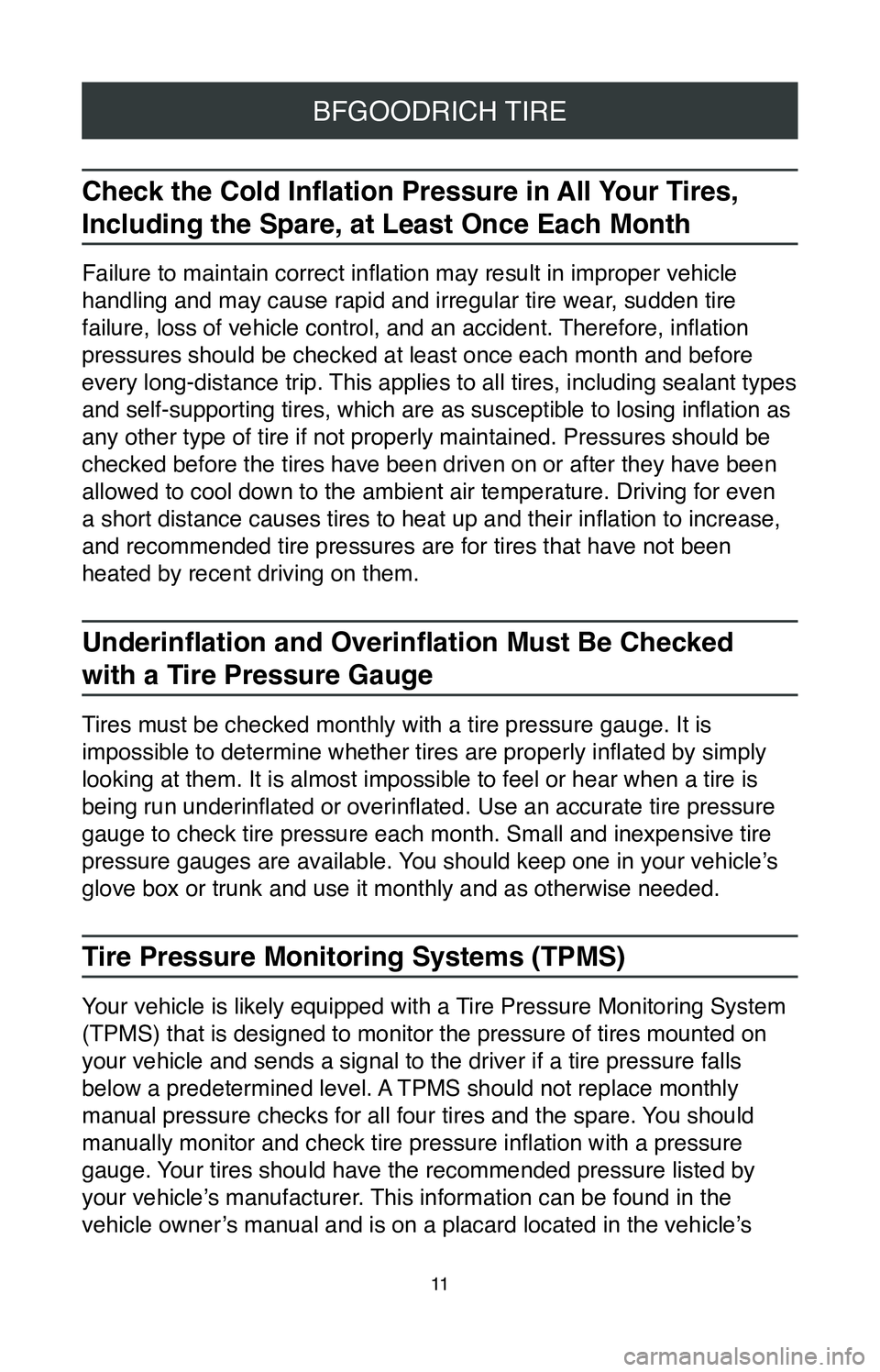
11
BFGOODRICH TIRE
Check the Cold Inflation Pressure in All Your Tires,
Including the Spare, at Least Once Each Month
Failure to maintain correct inflation may result in improper vehicle
handling and may cause rapid and irregular tire wear, sudden tire
failure, loss of vehicle control, and an accident. Therefore, inflation
pressures should be checked at least once each month and before
every long-distance trip. This applies to all tires, including sealant types
and self-supporting tires, which are as susceptible to losing inflation as
any other type of tire if not properly maintained. Pressures should be
checked before the tires have been driven on or after they have been
allowed to cool down to the ambient air temperature. Driving for even
a short distance causes tires to heat up and their inflation to increase,
and recommended tire pressures are for tires that have not been
heated by recent driving on them.
Underinflation and Overinflation Must Be Checked
with a Tire Pressure Gauge
Tires must be checked monthly with a tire pressure gauge. It is
impossible to determine whether tires are properly inflated by simply
looking at them. It is almost impossible to feel or hear when a tire is \
being run underinflated or overinflated. Use an accurate tire pressure
gauge to check tire pressure each month. Small and inexpensive tire
pressure gauges are available. You should keep one in your vehicle’s
glove box or trunk and use it monthly and as otherwise needed.
Tire Pressure Monitoring Systems (TPMS)
Your vehicle is likely equipped with a Tire Pressure Monitoring System
(TPMS) that is designed to monitor the pressure of tires mounted on
your vehicle and sends a signal to the driver if a tire pressure falls
below a predetermined level. A TPMS should not replace monthly
manual pressure checks for all four tires and the spare. You should
manually monitor and check tire pressure inflation with a pressure
gauge. Your tires should have the recommended pressure listed by
your vehicle’s manufacturer. This information can be found in the
vehicle owner’s manual and is on a placard located in the vehicle’s
Page 111 of 260
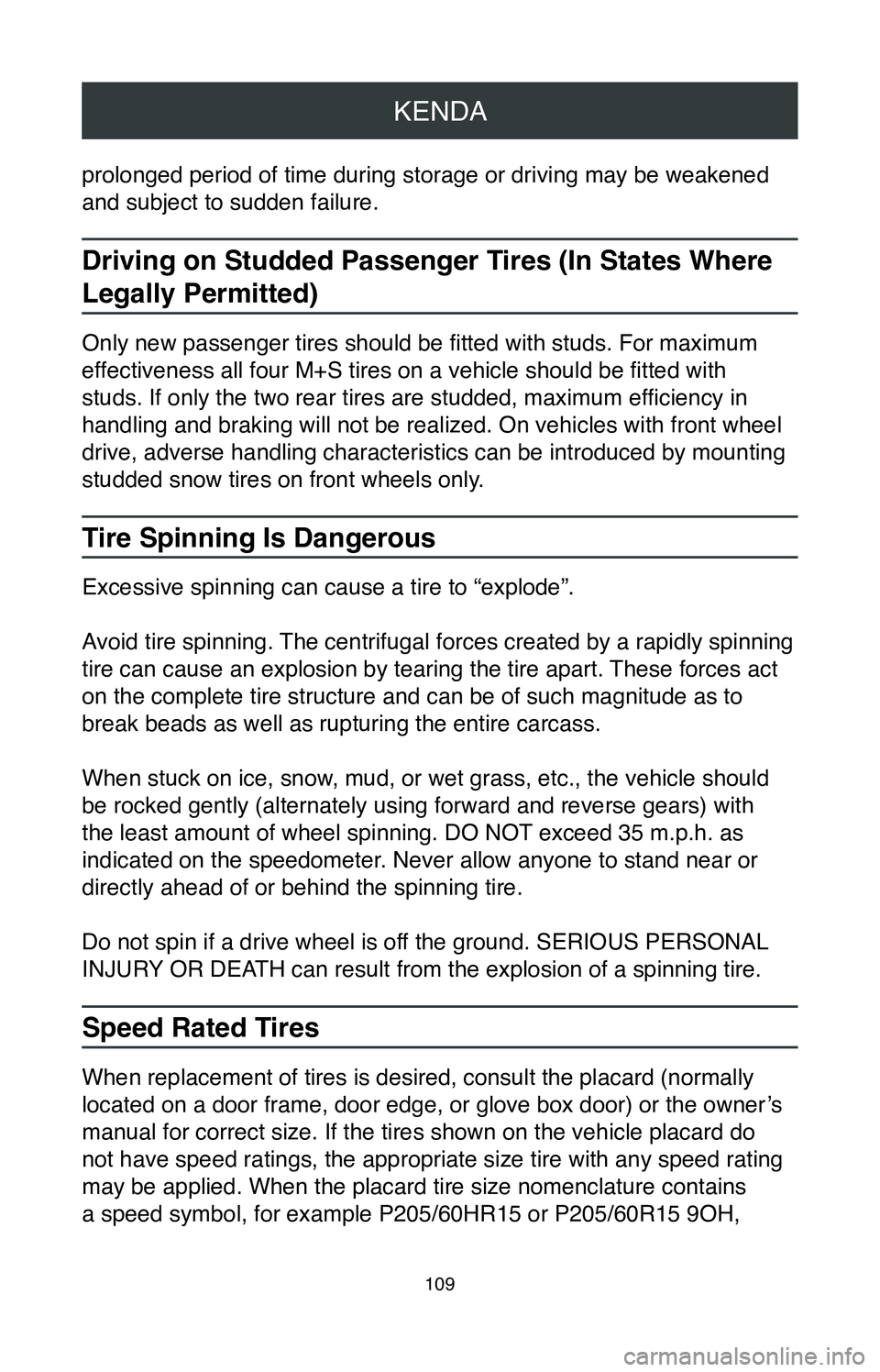
KENDA
109
prolonged period of time during storage or driving may be weakened
and subject to sudden failure.
Driving on Studded Passenger Tires (In States Where
Legally Permitted)
Only new passenger tires should be fitted with studs. For maximum
effectiveness all four M+S tires on a vehicle should be fitted with
studs. If only the two rear tires are studded, maximum efficiency in
handling and braking will not be realized. On vehicles with front wheel \
drive, adverse handling characteristics can be introduced by mounting
studded snow tires on front wheels only.
Tire Spinning Is Dangerous
Excessive spinning can cause a tire to “explode”.
Avoid tire spinning. The centrifugal forces created by a rapidly spinning
tire can cause an explosion by tearing the tire apart. These forces act
on the complete tire structure and can be of such magnitude as to
break beads as well as rupturing the entire carcass.
When stuck on ice, snow, mud, or wet grass, etc., the vehicle should
be rocked gently (alternately using forward and reverse gears) with
the least amount of wheel spinning. DO NOT exceed 35 m.p.h. as
indicated on the speedometer. Never allow anyone to stand near or
directly ahead of or behind the spinning tire.
Do not spin if a drive wheel is off the ground. SERIOUS PERSONAL
INJURY OR DEATH can result from the explosion of a spinning tire.
Speed Rated Tires
When replacement of tires is desired, consult the placard (normally
located on a door frame, door edge, or glove box door) or the owner’s
manual for correct size. If the tires shown on the vehicle placard do
not have speed ratings, the appropriate size tire with any speed rating \
may be applied. When the placard tire size nomenclature contains
a speed symbol, for example P205/60HR15 or P205/60R15 9OH,
Page 127 of 260
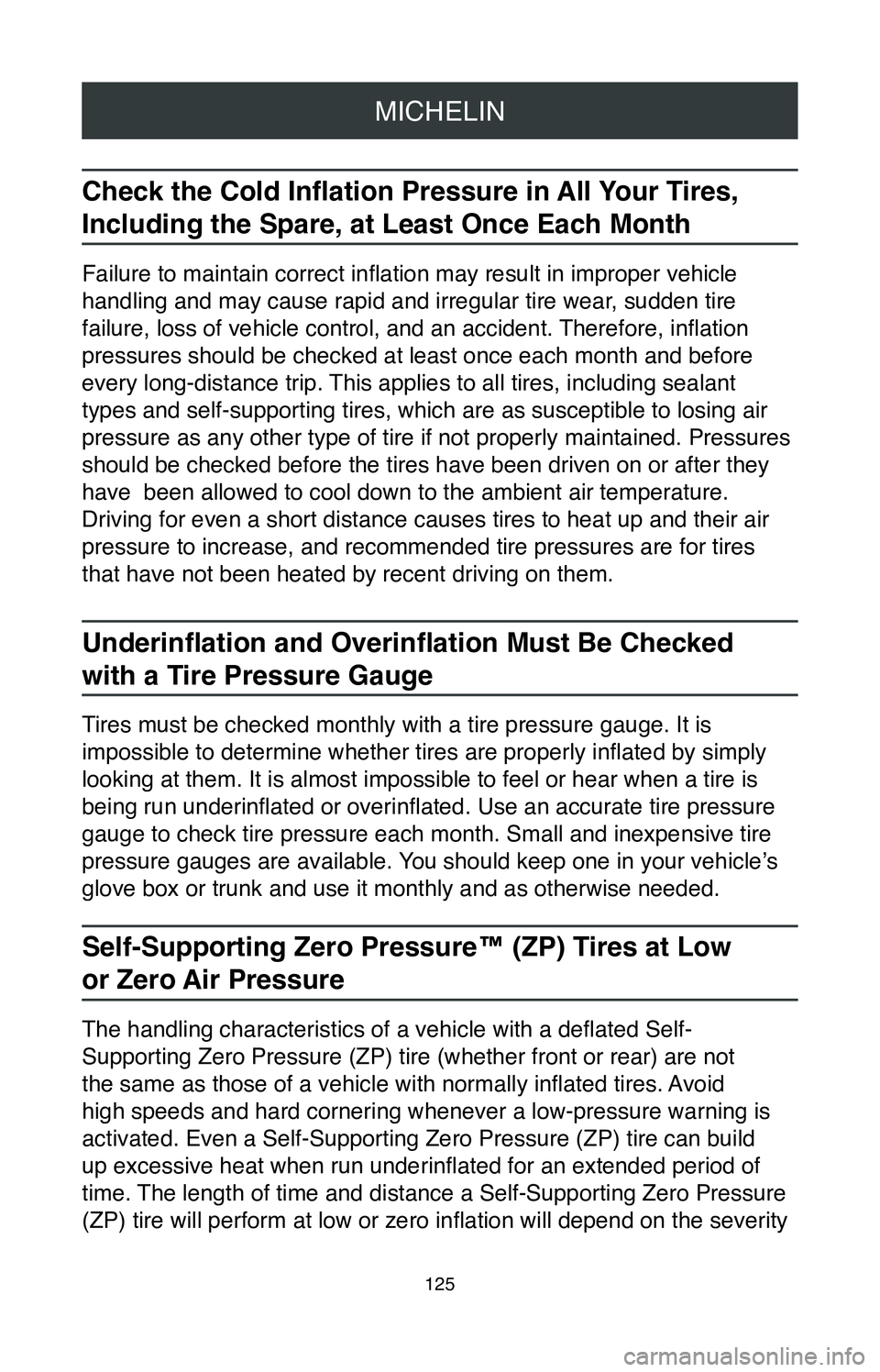
MICHELIN
125
Check the Cold Inflation Pressure in All Your Tires,
Including the Spare, at Least Once Each Month
Failure to maintain correct inflation may result in improper vehicle
handling and may cause rapid and irregular tire wear, sudden tire
failure, loss of vehicle control, and an accident. Therefore, inflation
pressures should be checked at least once each month and before
every long-distance trip. This applies to all tires, including sealant
types and self-supporting tires, which are as susceptible to losing air
pressure as any other type of tire if not properly maintained. Pressures\
should be checked before the tires have been driven on or after they
have been allowed to cool down to the ambient air temperature.
Driving for even a short distance causes tires to heat up and their air \
pressure to increase, and recommended tire pressures are for tires
that have not been heated by recent driving on them.
Underinflation and Overinflation Must Be Checked
with a Tire Pressure Gauge
Tires must be checked monthly with a tire pressure gauge. It is
impossible to determine whether tires are properly inflated by simply
looking at them. It is almost impossible to feel or hear when a tire is \
being run underinflated or overinflated. Use an accurate tire pressure
gauge to check tire pressure each month. Small and inexpensive tire
pressure gauges are available. You should keep one in your vehicle’s
glove box or trunk and use it monthly and as otherwise needed.
Self-Supporting Zero Pressure™ (ZP) Tires at Low
or Zero Air Pressure
The handling characteristics of a vehicle with a deflated Self-
Supporting Zero Pressure (ZP) tire (whether front or rear) are not
the same as those of a vehicle with normally inflated tires. Avoid
high speeds and hard cornering whenever a low-pressure warning is
activated. Even a Self-Supporting Zero Pressure (ZP) tire can build
up excessive heat when run underinflated for an extended period of
time. The length of time and distance a Self-Supporting Zero Pressure
(ZP) tire will perform at low or zero inflation will depend on the severity
Page 158 of 260
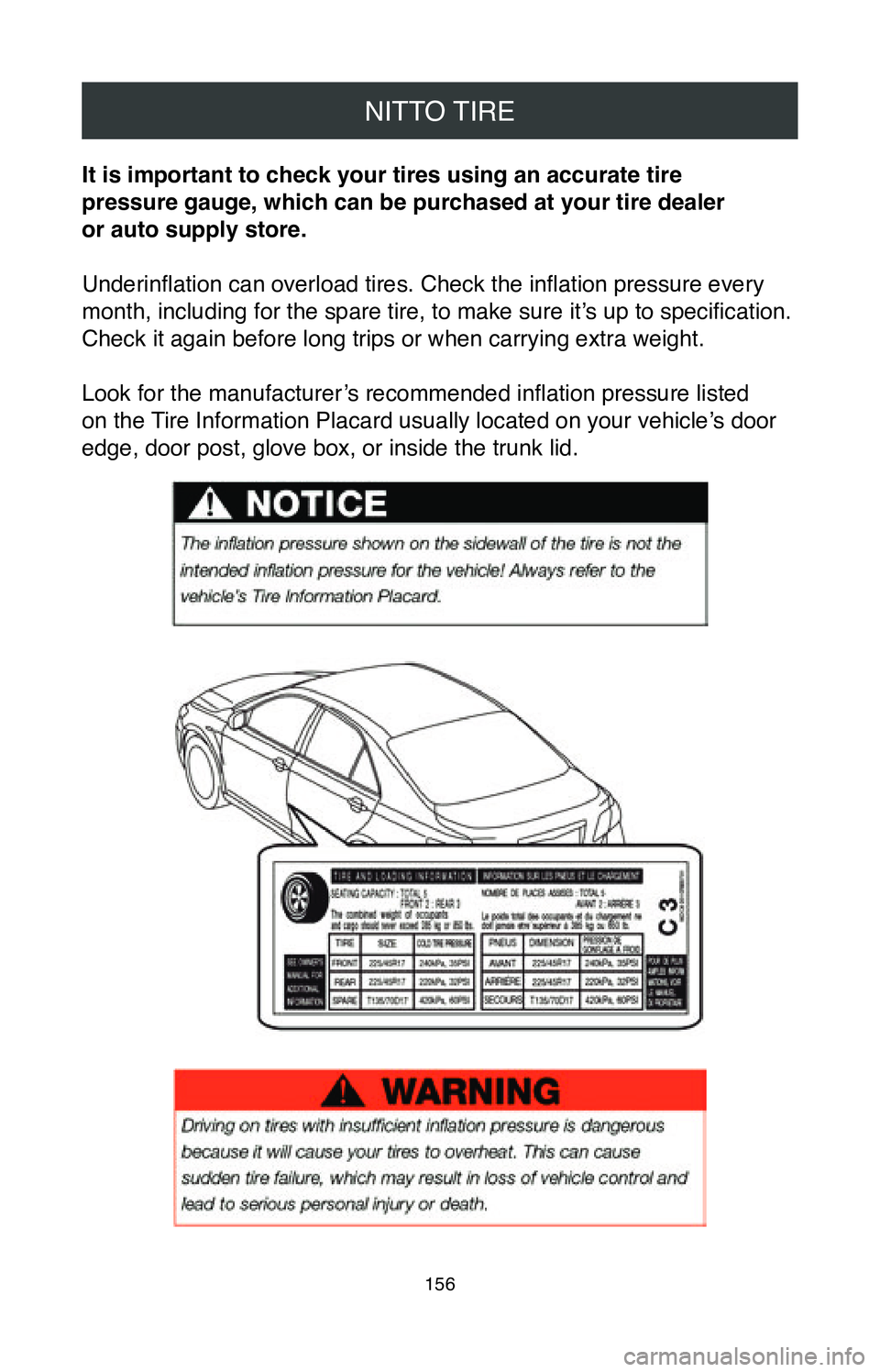
NITTO TIRE
156
It is important to check your tires using an accurate tire
pressure gauge, which can be purchased at your tire dealer
or auto supply store.
Underinflation can overload tires. Check the inflation pressure every
month, including for the spare tire, to make sure it’s up to specification.
Check it again before long trips or when carrying extra weight.
Look for the manufacturer’s recommended inflation pressure listed
on the Tire Information Placard usually located on your vehicle’s door
edge, door post, glove box, or inside the trunk lid.
Page 217 of 260
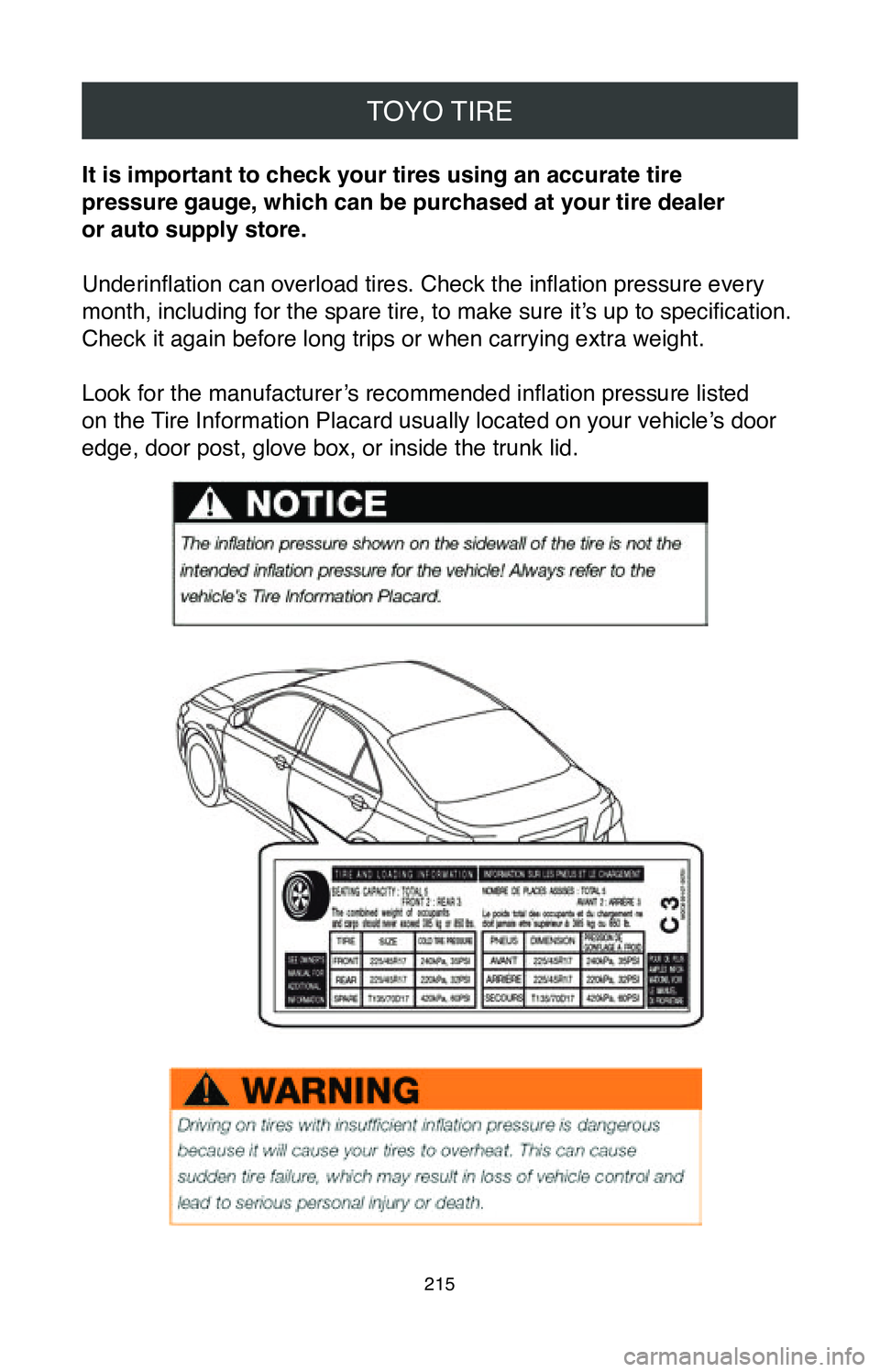
TOYO TIRE
215
It is important to check your tires using an accurate tire
pressure gauge, which can be purchased at your tire dealer
or auto supply store.
Underinflation can overload tires. Check the inflation pressure every
month, including for the spare tire, to make sure it’s up to specification.
Check it again before long trips or when carrying extra weight.
Look for the manufacturer’s recommended inflation pressure listed
on the Tire Information Placard usually located on your vehicle’s door
edge, door post, glove box, or inside the trunk lid.